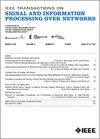Learning Hypergraphs Tensor Representations From Data via t-HGSP
IF 3
3区 计算机科学
Q2 ENGINEERING, ELECTRICAL & ELECTRONIC
IEEE Transactions on Signal and Information Processing over Networks
Pub Date : 2023-12-20
DOI:10.1109/TSIPN.2023.3345142
引用次数: 0
Abstract
Representation learning considering high-order relationships in data has recently shown to be advantageous in many applications. The construction of a meaningful hypergraph plays a crucial role in the success of hypergraph-based representation learning methods, which is particularly useful in hypergraph neural networks and hypergraph signal processing. However, a meaningful hypergraph may only be available in specific cases. This paper addresses the challenge of learning the underlying hypergraph topology from the data itself. As in graph signal processing applications, we consider the case in which the data possesses certain regularity or smoothness on the hypergraph. To this end, our method builds on the novel tensor-based hypergraph signal processing framework (t-HGSP) that has recently emerged as a powerful tool for preserving the intrinsic high-order structure of data on hypergraphs. Given the hypergraph spectrum and frequency coefficient definitions within the t-HGSP framework, we propose a method to learn the hypergraph Laplacian from data by minimizing the total variation on the hypergraph (TVL-HGSP). Additionally, we introduce an alternative approach (PDL-HGSP) that improves the connectivity of the learned hypergraph without compromising sparsity and use primal-dual-based algorithms to reduce the computational complexity. Finally, we combine the proposed learning algorithms with novel tensor-based hypergraph convolutional neural networks to propose hypergraph learning-convolutional neural networks (t-HyperGLNN).通过 t-HGSP 从数据中学习超图张量表示
考虑到数据中高阶关系的表征学习最近在许多应用中显示出优势。构建有意义的超图对基于超图的表征学习方法的成功起着至关重要的作用,这在超图神经网络和超图信号处理中尤其有用。然而,有意义的超图可能只在特定情况下才存在。本文探讨了从数据本身学习底层超图拓扑的挑战。与图信号处理应用一样,我们考虑的情况是数据在超图上具有一定的规则性或平滑性。为此,我们的方法建立在新颖的基于张量的超图信号处理框架(t-HGSP)之上,该框架最近已成为保存超图数据内在高阶结构的有力工具。考虑到 t-HGSP 框架中的超图频谱和频率系数定义,我们提出了一种通过最小化超图上的总变化(TVL-HGSP)从数据中学习超图拉普拉斯的方法。此外,我们还引入了另一种方法(PDL-HGSP),在不影响稀疏性的情况下提高学习到的超图的连通性,并使用基于基元二元的算法来降低计算复杂性。最后,我们将所提出的学习算法与基于张量的新型超图卷积神经网络相结合,提出了超图学习-卷积神经网络(t-HyperGLNN)。
本文章由计算机程序翻译,如有差异,请以英文原文为准。
求助全文
约1分钟内获得全文
求助全文
来源期刊

IEEE Transactions on Signal and Information Processing over Networks
Computer Science-Computer Networks and Communications
CiteScore
5.80
自引率
12.50%
发文量
56
期刊介绍:
The IEEE Transactions on Signal and Information Processing over Networks publishes high-quality papers that extend the classical notions of processing of signals defined over vector spaces (e.g. time and space) to processing of signals and information (data) defined over networks, potentially dynamically varying. In signal processing over networks, the topology of the network may define structural relationships in the data, or may constrain processing of the data. Topics include distributed algorithms for filtering, detection, estimation, adaptation and learning, model selection, data fusion, and diffusion or evolution of information over such networks, and applications of distributed signal processing.
 求助内容:
求助内容: 应助结果提醒方式:
应助结果提醒方式:


